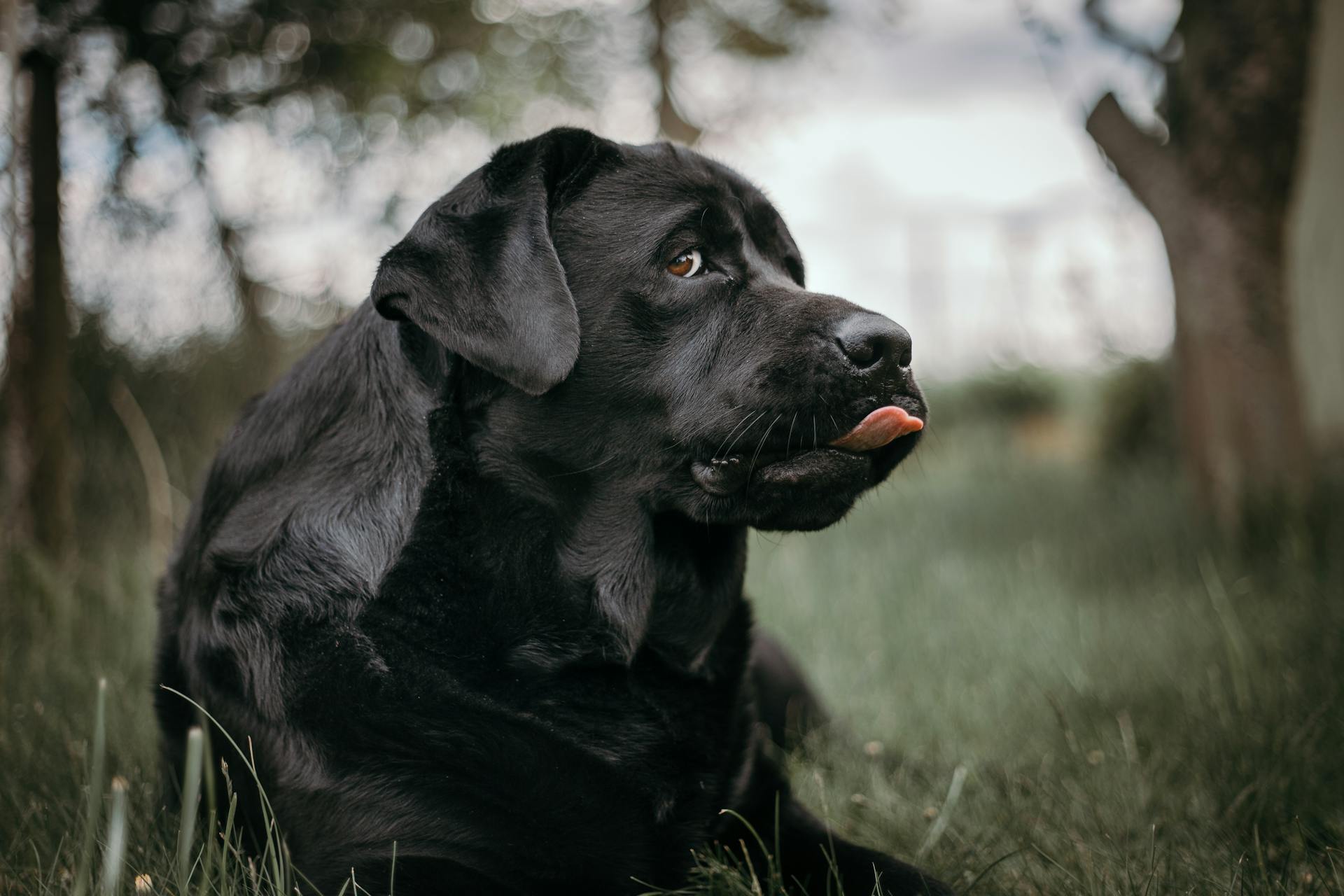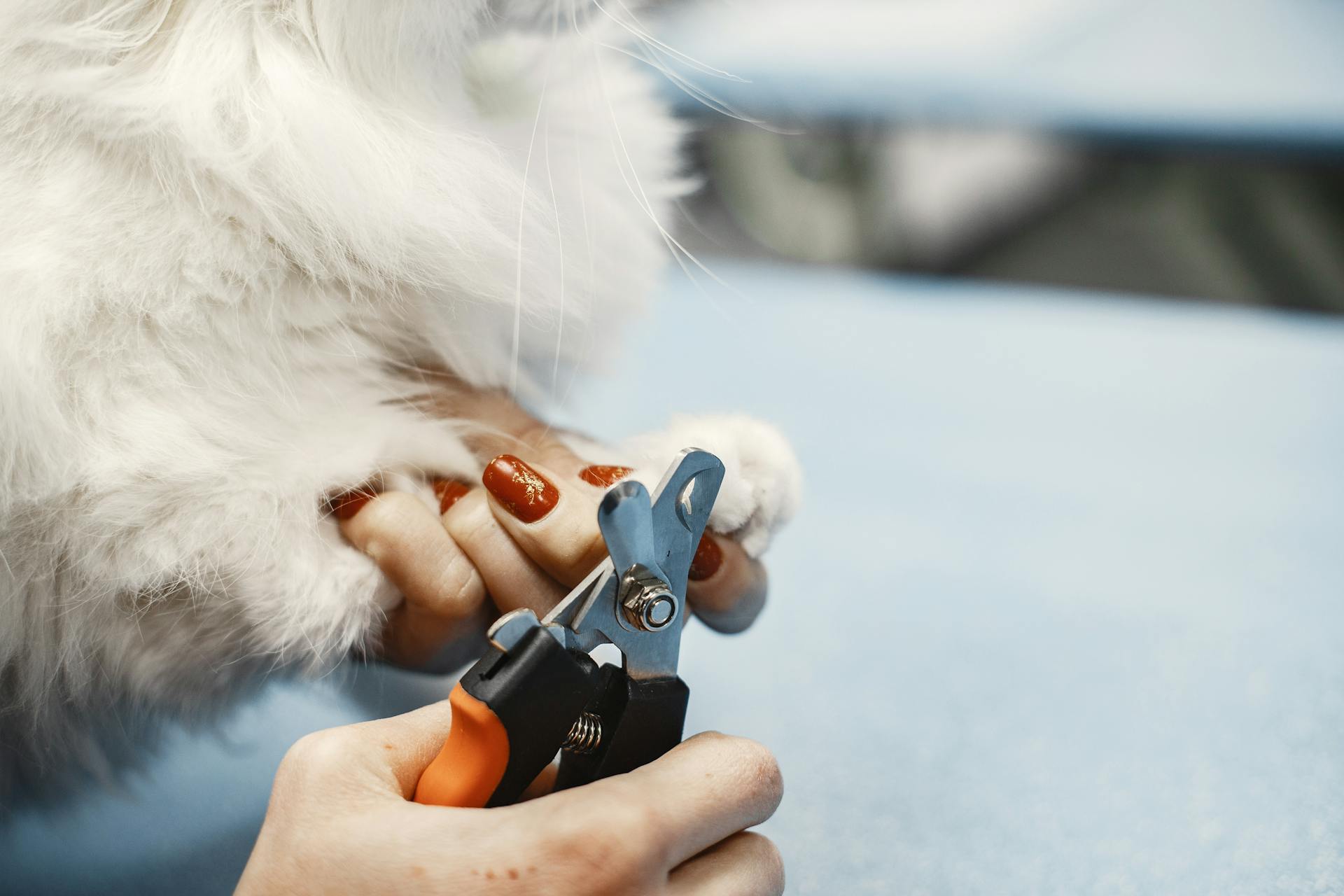
The Neapolitan Mastiff is a majestic breed, but their lifespan is a concern for many owners. On average, a Neapolitan Mastiff lives for 8-10 years.
Their large size and muscular build can lead to joint issues, such as hip dysplasia, which can affect their mobility and quality of life. This breed is prone to certain health issues.
A responsible breeder will prioritize the health and well-being of their dogs, often conducting regular health checks and genetic testing to identify potential issues. This can help identify potential problems early on.
For your interest: Longest Living Giant Dog Breeds
Health
As a Neapolitan Mastiff owner, you want to ensure your furry friend lives a long and healthy life. Brushing your dog's teeth daily will prevent periodontal disease.
Neapolitan Mastiffs are prone to heart disease, specifically dilated cardiomyopathy, which can lead to a weakened heart and breathing difficulties. Regular check-ups with your veterinarian can help catch this condition early.
Gastric Dilatation and Volvulus is another health concern for Neapolitan Mastiffs, which can be life-threatening if not treated promptly. Keeping an eye out for symptoms like bloating, vomiting, and lethargy can help you catch this condition early.
Regular exercise is essential for Neapolitan Mastiffs, but over-exertion can lead to joint problems. Keeping an eye on your dog's weight and feeding a high-quality diet can help prevent joint issues like arthritis.
Heart disease can be managed with medication and dietary supplements, but it's essential to catch it early. Regular electrical heart screenings and echocardiograms can help detect abnormal heart rhythms.
Bone and joint problems are common in Neapolitan Mastiffs, including elbow dysplasia, hip dysplasia, and cranial cruciate ligament injuries. Keeping your dog at a healthy weight and avoiding excessive twisting can help prevent these issues.
Osteochondritis dissecans, or OCD, can occur in Neapolitan Mastiffs if they grow too quickly. Feeding a large-breed puppy diet and avoiding overfeeding can help prevent this condition.
Care and Lifestyle
To ensure your Neapolitan Mastiff lives a long and happy life, it's essential to create a routine care schedule that includes regular exercise and a balanced diet. This will help her stay healthy and thrive in her golden years.
You should supervise your pet as you would a toddler, keeping doors closed and blocking off rooms as necessary to prevent her from getting into trouble. A weekly grooming routine is also a must, including brushing her coat and cleaning her ears.
A high-quality diet is crucial for your Mastiff's overall health, so feed her a consistent and balanced meal plan that's tailored to her age. Don't give her people food, as this can lead to digestive issues and other health problems.
Here's a quick rundown of daily care tasks to keep your Mastiff happy and healthy:
- Brush her coat at least weekly
- Clean her ears weekly
- Brush her teeth at least twice a week
- Check her eyes and skin folds often for signs of irritation
- Take her on daily walks and provide ample room to play
Environment and Living
Creating a safe and healthy living environment for your Neapolitan Mastiff is crucial for their well-being and longevity. Keep doors closed to prevent your pet from getting into trouble.
A clean and safe living space is essential for your Mastiff's health. This includes blocking off rooms as necessary to keep them out of harm's way.
Dogs that live in cramped or stressful environments are more likely to experience health problems. Provide your Mastiff with ample room to play and exercise.
Neapolitan Mastiffs can be sensitive to warm temperatures, so be sure to keep them cool and provide shade when needed. Avoid prolonged exposure to heat and be alert for signs of heat stress.
Clean living conditions are vital for your Mastiff's health. Regularly clean their ears, eyes, and skin folds to prevent infections.
Here are some key factors to consider when creating a healthy living environment for your Neapolitan Mastiff:
- Ample room to play and exercise
- A clean and safe living space
- Proper ventilation and temperature control
- Regular cleaning of ears, eyes, and skin folds
Why Some Live Longer Than Others
A Neapolitan Mastiff's lifespan can be significantly impacted by its size, with larger dogs often living shorter lives due to the increased risk of health problems.
Nutrition plays a crucial role in a Neapolitan Mastiff's lifespan, and feeding them a high-quality, balanced diet is essential.
Genes and breeding history also have a significant impact on a Neapolitan Mastiff's lifespan, with some lines being bred for longevity and others for specific characteristics.
Environment and living conditions can also affect a Neapolitan Mastiff's lifespan, with dogs living in areas with extreme temperatures or poor air quality being more prone to health issues.
Healthcare is another critical factor, with regular veterinary check-ups and preventative care helping to identify and manage potential health problems early on.
The sex of a Neapolitan Mastiff can also impact its lifespan, with females generally living longer than males due to their lower risk of certain health issues.
For more insights, see: Neapolitan Mastiff Health
6 Life Stages
As Neapolitan Mastiffs age, they go through distinct life stages. The first stage is puppyhood, which can last up to 18 months in large and giant breeds.
During this time, it's essential to provide them with puppy food to ensure they get the right nutrition as they grow. This is crucial for their development and overall health.
Neapolitan Mastiffs are considered young adults from 3-4 years old, and it's common to see some puppy-like behavior at this stage. They're still maturing and learning about their surroundings.
Broaden your view: Blue Neapolitan Mastiff Puppy
As they mature, Mastiffs enter the adult stage, which lasts from 3-4 to 7 years old. At this point, they're no longer growing, and it's essential to monitor their food intake to prevent obesity.
In the adult stage, Mastiffs reach the last 25% of their estimated lifespan. Since they're large dogs, joint and mobility issues can become a concern.
Mastiffs enter the senior dog stage when they're in the last 25% of their estimated lifespan. This breed is estimated to live up to 10 years, so seniorhood typically begins around 7-10 years old.
Here are the six life stages of a Neapolitan Mastiff:
- Puppy: 0-18 months
- Young Adult: 3-4 years old
- Adult: 3-4 to 7 years old
- Senior: 7-10 years old
How to Determine Your Age
Determining your Neapolitan Mastiff's age can be a bit tricky, but there are some signs to look out for. Their teeth are a good indicator, as puppies have sharp, white teeth, while older dogs may have yellowed or worn-down teeth.
As your dog ages, their eyes may develop a cloudy or gray appearance, which can be a sign that they're getting older. This is a natural process, but it's still worth keeping an eye on.
The condition of your dog's coat can also provide clues about their age. Older dogs may have thinning or graying fur, which can be a sign that they're not as spry as they used to be.
Here are some age-related changes you might notice in your Neapolitan Mastiff:
- Teeth: sharp, white (puppy), yellowed or worn-down (older dog)
- Eyes: cloudy or gray (older dog)
- Coat: thinning or graying (older dog)
- Activity Level: decreased (older dog)
As your dog's activity level decreases with age, you may notice they're not as energetic or playful as they used to be. This is a normal part of the aging process, but it's still worth monitoring their overall health.
The Average Lifespan
Neapolitan Mastiffs typically live between 8 and 10 years.
Their lifespan can vary depending on a variety of factors.
It's not uncommon for some Neapolitan Mastiffs to live longer or shorter than this average range.
Suggestion: Life Expectancy of Husky Dogs
Sources
- https://dogtime.com/dog-breeds/neapolitan-mastiff
- https://www.dogbreedslist.info/all-dog-breeds/neapolitan-mastiff.html
- https://allpetsvc.com/client-resources/breed-info/neapolitan-mastiff/
- https://www.hepper.com/neapolitan-mastiff-lifespan-how-long-do-they-live/
- https://www.dogster.com/dog-health-care/mastiff-lifespan-how-long-do-they-live
Featured Images: pexels.com


